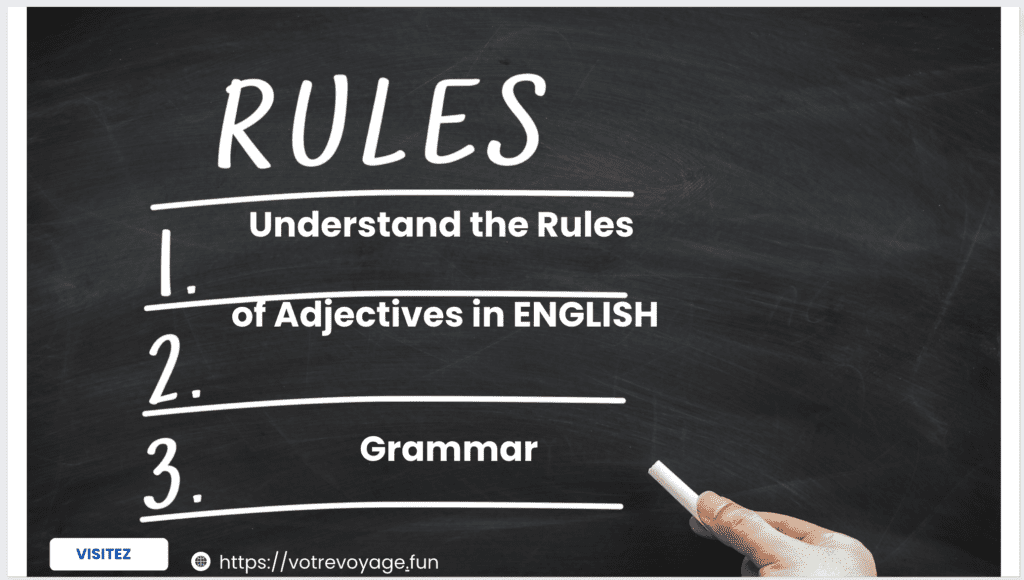
How to Use Adjectives and Adverbs in ENGLISH
Adjectives and adverbs are words that describe things. They can make your language more interesting and expressive. To learn how to use them in English you need to practice a lot. Here are some tips to help you.
To use adjectives and adverbs effectively in English, consider the following points:
- Adjectives in English:
- Adjectives describe nouns and provide more information about them.
- They can express qualities, characteristics, size, color, origin, and more.
- Adjectives usually come before the noun they modify, but they can also come after the verb “to be” (e.g., “The sky is blue”).
- Adjectives can be comparative (comparing two things) or superlative (comparing more than two things) by adding “-er” or “-est” respectively, or by using “more” and “most” (e.g., “taller,” “the tallest,” “more interesting,” “the most beautiful”).
- Adverbs in English:
- Adverbs describe verbs, adjectives, or other adverbs.
- They provide information about how, when, where, or to what extent an action occurs.
- Adverbs often end in “-ly” (e.g., “quickly,” “carefully,” “beautifully”).
- They can be used to modify verbs (e.g., “She runs quickly”), adjectives (e.g., “He is extremely talented”), or other adverbs (e.g., “She sings very softly”).
Remember that practicing and using adjectives and adverbs in context will help you become more proficient. Try incorporating them into your conversations, writing, and reading to reinforce your understanding.
Understand the Rules of Adjectives in ENGLISH Grammar

To develop the point of understanding the rules of adjectives in English grammar, consider the following:
- Adjectives in English are words that provide additional information about a noun or pronoun. They can be placed in different positions within a sentence [1].
- Adjectives are used to describe various aspects, such as people, places, animals, things, feelings, qualities, characteristics, nationality, origin, age, size, measurement, color, material, shape, and judgment or value [2].
- There is a specific order known as the Royal Order of Adjectives that is followed in English. The order is as follows: determiner, opinion, size, shape, age, color, origin, material, and purpose. However, it is important to note that not all adjectives need to be included in every sentence and some categories may be omitted depending on the context [3].
- Adjectives usually precede the noun they modify in English. However, there are cases where adjectives can follow the verb “to be” in a sentence. Both positions are correct and can be used interchangeably depending on the emphasis or style of the sentence [3].
By understanding these rules, you can effectively use adjectives to provide detailed descriptions in English sentences.
Learn New Words that Can Describe People, Places, and Situations

To develop the point of learning new words that can describe people, places, and situations, consider the following:
- Building your vocabulary is essential for effectively describing people, places, and situations. By expanding your repertoire of descriptive words, you can communicate more precisely and vividly.
- Engage in activities specifically designed to help you learn new words for describing people, places, and situations. Websites like Cambridge English offer resources and exercises to enhance your vocabulary skills, providing adjectives and phrases that can be used to describe various things and individuals .
- One effective method for learning new words is through contextual reading. Reading articles, stories, or books exposes you to diverse language and allows you to encounter words in meaningful contexts. The New York Times, for example, offers a wealth of engaging articles that can introduce you to new vocabulary related to people, places, and situations .
- Actively seek out opportunities to learn and practice new words. Language learning platforms, such as the British Council, provide valuable tips and strategies for language learners, including techniques for expanding your vocabulary .
- Create a personalized vocabulary learning routine that suits your preferences and learning style. This might involve using flashcards, participating in language exchange programs, watching movies or TV shows in the target language, or engaging with language learning apps that focus on vocabulary acquisition.
- Practice using the newly acquired words in context. Incorporate them into your speaking and writing exercises to reinforce your understanding and fluency. Additionally, engage in conversations or discussions that allow you to utilize these words and receive feedback on your usage.
By actively seeking out resources and implementing effective vocabulary learning strategies, you can steadily expand your word bank and develop the ability to describe people, places, and situations with greater precision and depth. Remember to practice regularly and integrate the new words into your language usage to solidify your learning.
You can find many adjectives and adverbs in dictionaries, books, or online resources. Try to learn words that are useful and relevant for you. For example, if you like traveling, you can learn words that describe different countries, cultures, or landscapes. If you like sports, you can learn words that describe different activities, skills, or performances. Practice using these words in different sentences and contexts.
Describe Different Scenarios Using Adjectives and Adverbs

To develop the point of describing different scenarios using adjectives and adverbs, consider the following:
- Adjectives and adverbs play a crucial role in providing vivid and detailed descriptions of different scenarios. Adjectives modify nouns, adding specific qualities or attributes to them, while adverbs modify verbs, adjectives, or other adverbs, providing information about how, when, where, or to what extent an action occurs .
- When describing different scenarios, adjectives allow you to convey the characteristics, qualities, or emotions associated with people, places, or things. For example, you can use adjectives to describe a serene beach, a bustling city, or a mysterious forest, providing a clear picture to the reader or listener [2].
- Adverbs, on the other hand, enable you to describe how actions are performed or the manner in which something happens in a scenario. They provide additional information that helps paint a more complete picture. For instance, you can use adverbs to describe someone walking briskly, speaking softly, or driving cautiously, enhancing the overall description of the scenario .
- Consider the placement of adjectives and adverbs in your sentences to achieve the desired effect. While adjectives are typically placed before the noun they modify, adverbs can be positioned before or after the verb or adjective they modify. Adverbs have more flexibility and can be moved around in a sentence to emphasize different aspects .
- Experiment with a variety of adjectives and adverbs to capture the essence of different scenarios. Choose words that accurately depict the sensory details, emotions, or actions involved, enabling the reader or listener to engage with the scenario on a deeper level.
By incorporating carefully selected adjectives and adverbs, you can bring your descriptions to life and effectively convey different scenarios to your audience. Remember to consider the specific context and purpose of your writing, and strive to create a vivid and engaging experience for your readers or listeners.
You can use your imagination or real-life examples. For example, you can describe a beautiful sunset, a kind person, or a stressful situation. Try to use different adjectives and adverbs that show the details and feelings of each scenario.
Practice Talking or Writing About Different Scenarios Using Adjectives and Adverbs

To develop your practice of talking or writing about different scenarios using adjectives and adverbs, you can follow these steps:
Start by understanding the role of adjectives and adverbs in adding description to your writing. Adjectives are words that describe or modify nouns, while adverbs describe or modify verbs, adjectives, or other adverbs .
Watch videos or tutorials that provide examples and explanations on using adjectives and adverbs effectively in creative writing. The BBC Bitesize website offers resources with videos and activities that can help you understand how to use adjectives and adverbs to add description and create engaging writing [1].
Practice incorporating adjectives and adverbs in your writing by selecting different scenarios or topics to describe. Start with simple scenarios and gradually increase the complexity as you become more comfortable. Use a combination of adjectives and adverbs to provide vivid and detailed descriptions of people, places, and situations .
Experiment with the placement of adjectives and adverbs in your sentences to create variety and make your writing more interesting. Adjectives can be placed before or after the noun they modify, while adverbs can be positioned before or after the verb or adjective they modify [2].
Engage your senses and use descriptive techniques such as imagery, alliteration, and onomatopoeia to enhance your writing. These techniques can help create a vivid and immersive experience for your readers .
Seek feedback from others, such as teachers, peers, or writing groups, to further improve your skills in using adjectives and adverbs effectively. Their insights and suggestions can help you refine your writing and make it more impactful.
Remember, practice is key to mastering the use of adjectives and adverbs in your writing. The more you engage in this practice, the more confident and skilled you will become in describing different scenarios with clarity and creativity.
You can practice with other people who speak French or with language partners online. You can have conversations or write texts about different topics using adjectives and adverbs.
By following these tips, you can use adjectives and adverbs in French effectively. The more you practice, the better you will get at using them. Adjectives and adverbs can make your language more colorful and lively.
For more tips visit justpractice.online